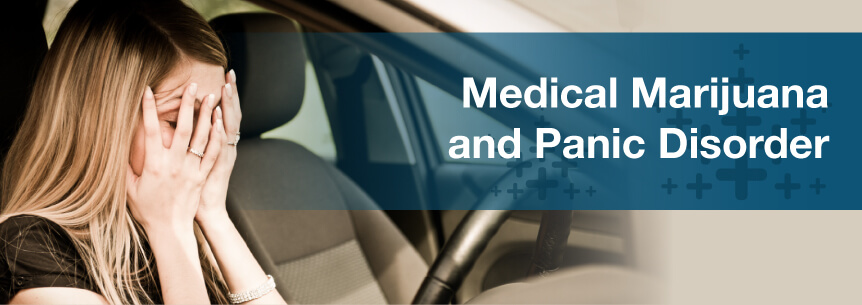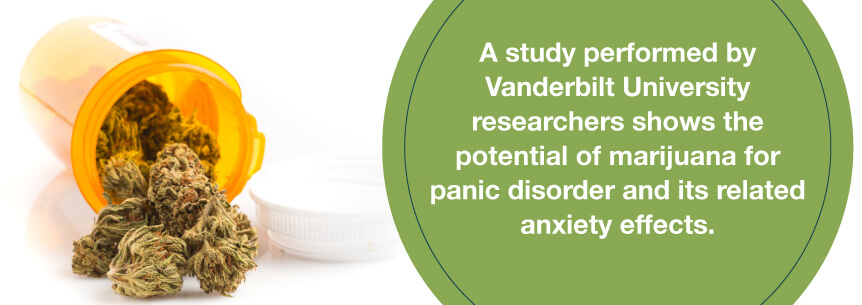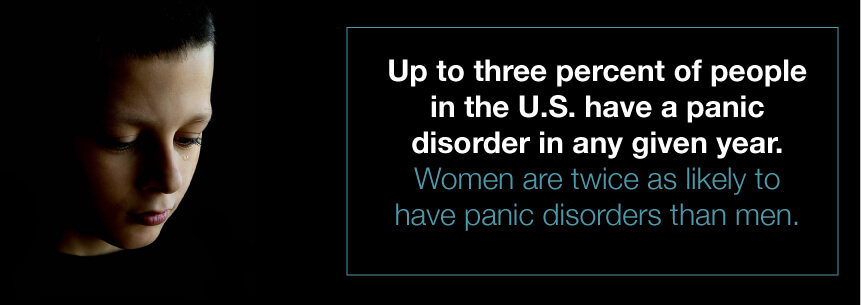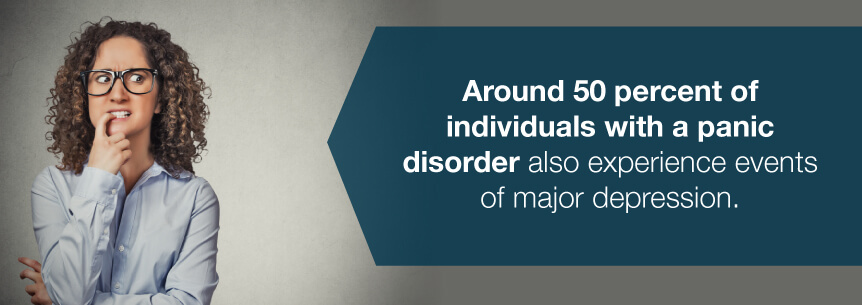
Are you feeling worried, uneasy or concerned? Do these feelings seem to persist on a daily basis? If so, you could be struggling with a panic disorder. People with panic disorders may feel anxious to the point that it affects their relationships, work life and overall well-being.
Luckily, you can manage your panic disorder symptoms without the harsh side effects of traditional treatments — in fact, you can do this by using medical marijuana for panic disorders.
Some marijuana advocates say cannabis helps combat stress. However, other research claims cannabis is associated with psychosis. At higher doses, marijuana may induce more stress and even panic attacks. However, in low quantities, it can substantially reduce worry and anxiety. CBD, one of marijuana’s active ingredients that you’ll find most prevalent in indica strains, is effective at dealing with stress and anxiety.
So, when you dose your herb properly according to the recommendation of a doctor, medical weed — particularly when using strains high in CBD and low in THC — could be a significantly safer and more effective alternative than the more traditional medications doctors commonly prescribe for panic disorder.
Find A Doctor Find A Dispensary
A study performed by Vanderbilt University researchers shows the potential of marijuana for panic disorder and its related anxiety effects. In mice, the researchers found cannabinoid receptors monitor the flight-or-fight response and anxiety in the brain’s emotional hub. They claim this is the first time these receptors have been identified in the amygdala brain region in mice models.

Although there is an abundance of anxiety medications, such as sedatives and SSRIs, those patients who aren’t happy often look for something more fast-acting and natural with less harsh side effects. For most of these patients, marijuana is the answer. There’s sound science behind cannabis containing compounds that work to reduce anxiety at a cellular level when dosed properly.
Animal and cell studies, patient self-reports and human trials all show marijuana causes sedation, leading to a decrease in anxiety in many patients. Certain studies involving healthy participants and animal models show CBD has anxiolytic-like effects and decreases anxiety in individuals who are struggling with social anxiety disorder.
Another study reports pretreatment with CBD reduced cognitive impairment, anxiety and speech performance discomfort, decreasing anticipatory speech alert significantly.
Individuals with social phobia who used CBD experienced reduced discomfort, cognitive impairment and anxiety when asked to participate in a simulated public speaking situation.
Multiple factors contribute to cannabis’s effect on anxiety, including:
All influence whether a person is relaxed or panicked after using medical weed.
The relationship between marijuana and panic disorder was first acknowledged in 1563, when Garcia de Orta, a Portuguese physician, stated cannabis could deliver those struggling with anxiety from “all worries and care.” Consumers described cannabis effects as relaxing, calming and even hypnotic.
Almost half a millennia ago in 1621, Robert Burton, an English clergyman, recommended marijuana to treat depression, a common symptom of panic disorders.
Despite their popularity, many mainstream panic disorder medications come with agonizing side effects patients often find worse than the actual disorders themselves. Depression, insomnia, suicidal thoughts and hallucinations are only some of the common side effects of these medications.
Unlike cannabis, these medications lead to physical addiction and withdrawal when you stop them abruptly. Additionally, these medications may also lead to overdose — something that doesn’t ever happen with cannabis.
Medical marijuana has been widely studied as an anti-anxiety treatment and found to be beneficial to some sufferers of anxiety-related disorders. Studies have shown medical marijuana can cause anxiety in some patients. However, others report the use of medical marijuana significantly reduces stress and anxiety. Individual body chemistry appears to dictate whether or not medical marijuana produces a relaxing, anti-anxiety reaction in a patient or not.
Although medical marijuana does not produce serotonin, the chemical produced or increased by some of the traditional anti-anxiety, anti-seizure, or anti-depressant drugs, marijuana does affect a brain substance known as anandamide. When anandamide reacts with the THC found in marijuana, it produces a calming or soothing effect throughout the body which can decrease the anxiety felt by a panic disorder sufferer, thereby reducing the likelihood of an attack.
Along with decreasing anxiety and stress for a panic disorder sufferer, medical marijuana has also been shown to decrease other symptoms of panic disorder such as nausea that often precipitates or accompanies a panic attack. Cannabidiol, or CBD, is one of the major components of medical marijuana. Clinical studies have shown CBD contains chemical properties with the ability to reduce anxiety, alleviate nausea and even prevent or reduce convulsions.
For sufferers of panic disorder, medical marijuana offers an alternative to traditional medications potentially offering the same benefits without many of the negative side-effects accompanying traditional medications.
Panic attacks might not respond to standard anxiety medication treatment. The good news is there are powerful cannabis strains shown to treat panic disorder effectively.
Indica-dominant hybrids have higher levels of CBD and lower THC content, which may help reduce your panic disorder symptoms. When choosing your indica-dominant hybrid strains, look for 80 to 20 percent, 90 to 10 percent or 100 percent indica.
For anxiety and panic disorders, cannabis that’s higher in CBD and lower in THC strains is beneficial for you. Potentially helpful marijuana strains for panic disorder include:
These strains can help to reduce panic attack symptoms by:
Some panic disorder patients report they experience more relief from using 100 percent indica or indica-dominant strains — others prefer sativa strains. You’ll want to do your own experimenting if you’re trying cannabis for the first time to find the ones you like the most. Work with your budtender and doctor to find the right strain for you.
Patients find cannabis oil helps with their anxiety by regulating their responses to stressors but not impacting their work or relationships. Typically, it takes just one puff of marijuana to give you anxiety relief, but because of the nature of anxiety, many sufferers find they must continue treating themselves throughout the day to continue their relief. Because of this, they prefer cannabis oil’s discreetness and long-lasting effects.
CBD-dominant cannabis oil provides you with a gentle medication with very little side effects. CBD counteracts the psychoactive effects of THC, but also has potent anti-anxiety qualities, providing tolerable, safe relief from various panic disorders.
Marijuana flavors or cannabis extracts can be vaporized, smoked or eaten. More patients are medicating by eating cannabis-infused food or sprays that go right under their tongue. These CBD products are usually non-psychoactive, which is ideal for parents, children, seniors and professionals who don’t like the “high” feeling.
While smoking raw marijuana flowers rich in THC, CBD or both is the traditional way of getting your treatment, more modern methods are being used, like vape cartridges and sublingual sprays, to deliver the medicine’s benefits in a healthier way.
If you’re struggling with a panic disorder and find your life is out of control, you may benefit from marijuana as a panic disorder treatment. Get started by finding a licensed, marijuana-friendly doctor who can evaluate your condition. They’ll be able to decide whether medical marijuana would help you find relief from panic attacks. Be sure to read up on your state’s laws before starting your search.
Search for a medical marijuana dispensary near you, or connect with a doctor to get the process started.
Find A Doctor Find A Dispensary
A panic attack occurs when you experience intense fear suddenly with no real apparent cause or true danger triggering a physical reaction. Panic attacks can be extremely frightening. When they happen, you may feel like you’re having a heart attack, losing control or even like you’re dying.
Up to three percent of people in the U.S. have a panic disorder in any given year, reports the Anxiety and Depression Association of America. Women are twice as likely to have panic disorders than men. Panic disorders may interfere with your daily life, causing you to miss work and avoid situations you fear may trigger an attack. You may go to many doctor visits because you overreact to every symptom you experience. If you also have agoraphobia — a fear of places possibly causing embarrassment or panic — this interference is much worse.

Anxiety disorders, in some cases, run in the family. However, it’s not known why some members of the family get it and others don’t. It’s thought that biological processes and various parts of your brain could play a role in anxiety and fear. Researchers say individuals who have panic disorders may think their harmless body sensations are threats. As scientists learn more about how the body and brain function in individuals with panic disorder, they might be able to develop more effective treatments.
Some individuals don’t know or believe their panic disorder is real. Others are embarrassed or afraid to tell anybody about what they’re experiencing due to fear of rejection or being considered a hypochondriac — including by their loved ones and doctors. They instead struggle with their disorder in silence and distance themselves from family, friends and other people who could be supportive or helpful.
Even though panic attacks by themselves don’t threaten your life, they’re incredibly frightening and can affect your quality of life. Fortunately, many types of treatments are available to help.
There are six primary types of panic disorders.
Two main characteristics of panic disorder are worry and fear. Although there’s no real danger, people affected still experience physical reactions like heavy breathing, nausea and shaking, as if there’s some immediate threat. They constantly worry about when their next attack will spring on them.
Individuals who have phobias fear specific activities, objects and scenarios to an excessive degree. Their fear is often out of proportion, even though the things they’re worried about don’t pose any danger. Some examples include fear of insects, heights and snakes. Individuals with phobias usually go to great lengths to avoid the things they’re frightened of, and this often worsens their condition.
When you’re troubled by potentially harmful things but the likelihood of them occurring is not great, you’re said to have a generalized anxiety disorder. You might feel worried all the time under these conditions without any justification. Your anxiousness is so abnormal it hinders your ability to unwind or carry out your daily routines.
Social anxiety disorder, also called social phobia, is characterized by an intense fear of being labeled with a bad reputation. Social phobia can make you extremely shy and cause you to avoid social interactions due to fear of being publicly embarrassed. An excellent example of social phobia is stage fright.
Unwanted thoughts and behaviors, which can take over your self-control, characterize OCD. For example, your mind keeps you worrying about whether you’ve turned the oven off before you left the house. OCD may have you excessively repeating specific actions, like locking the door or washing your hands.
Participation in war, near-death experiences and other traumatic events may cause you to feel frightened, sad and detached from others. With PTSD, these adverse effects continue for extended time periods and result in an inability to live normally and hypervigilance.
The American Psychiatric Association was the first to recognize anxiety disorders in 1980. Before this, individuals who struggled with these disorders thought they had problems with their nerves or stress. Since health professionals didn’t understand the disorders, few individuals received effective treatment.

International research, since 1980, has associated these disorders with severe disabilities, preventable with early diagnosis and treatment. Some of these disabilities include:
The media has picked up more on the prevalence of panic attacks, anxiety and panic disorders recently. As more people acknowledge the presence of panic disorders, there’s more interest in treating the disorders.
Panic attacks are strong, sudden feelings of fear characterized by four or more of the following symptoms:
Panic attacks typically pass after between five and 10 minutes, but severe episodes can persist for hours. During an attack, you may feel as though you’re having a stroke or heart attack. Individuals having an attack often end up in the emergency room because of this.
When you have an untreated panic disorder, it may and sometimes does lead to agoraphobia. This is a type of anxiety disorder that develops after you have one or more panic attacks. Symptoms of agoraphobia include avoidance and fear of situations and places causing feelings of entrapment, panic, embarrassment or helplessness.
The anxiety can get worse if left untreated, to the point where your panic attacks are significantly affecting your life, or the act of trying to conceal or avoid them impacts your life. You may experience some periods where you don’t have any attacks, but they don’t usually go away unless you receive treatment designed specifically for these types of attacks. Panic disorders hinder your quality of life since they can lead to other mental health problems, fears, social isolation and problems at school or work.
Around 50 percent of individuals with a panic disorder also experience events of major depression. Co-disorders of depression and panic disorder have substantial and possibly grim implications — the high suicide attempt rates with panic disorders are heightened even more with a comorbid depression presence.

Statistics about panic disorder according to the ADAA include:
Physicians traditionally treat panic disorder with anti-anxiety, anti-depressant and anti-seizure medications aimed at reducing the patient’s anxiety level and unfounded fears. Unfortunately, most of these medications also come with significant negative side-effects that make them less than perfect treatment solutions for sufferers from panic disorder.
Many of the medications physicians commonly prescribe for panic disorder carry with them a high risk of becoming dependent on the medications. Interestingly, one of the more common potential side effects of many of the traditional panic disorder medications is anxiety itself.
Researchers don’t know the cause of panic attacks, so the treatment recommended for patients suffering from this condition can vary. There are several methods used, including cognitive-behavioral therapy, psychotherapy, meditation and relaxation.
In some instances, psychotherapy is used to help minimize fear and help prevent an attack from occurring. Cognitive-behavioral therapy helps patients face their problem by realizing irrational beliefs trigger their attacks, leading them to think something horrible is about to happen.
This approach is gradual, slowly desensitizing patients to the kinds of situations usually triggering feelings such as panic and anxiety. The feelings can also lead to physical problems, such as leading the sufferer to believe the they are suffering a heart attack. Medication is usually used to try to prevent an attack or alleviate symptoms.
Someone experiencing a panic attack may first turn to a sedative or anti-anxiety drug, such as Xanax or Ativan, which is typically recommended at the start of a treatment program but not for long-term use. Prozac, Celexa and Paxil are antidepressants designed to prevent anxiety and reduce the frequency and severity of panic attacks. Newer drugs, such as Neurontin and Lyrica, have also shown promise in experimental trials.
Medications used to treat panic attacks can cause severe side effects and even produce more attacks. It’s important for patients to start with low doses of medicine and only increase them if a doctor recommends it. Here are a few side effects associated with some of the drugs typically prescribed for panic disorders:
Medical marijuana, however, offers an alternative to these medications that does not carry with it the same negative side effects, yet offers many of the same positive benefits. Medical marijuana can help a panic disorder suffer reduce anxiety, eliminate stress and prevent or reduce nausea associated with the issue.